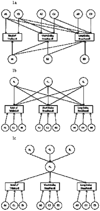Genetic architecture of learning and delayed recall: a twin study of episodic memory
- PMID: 21463045
- PMCID: PMC3125484
- DOI: 10.1037/a0022569
Genetic architecture of learning and delayed recall: a twin study of episodic memory
Abstract
Objective: Although episodic memory is often conceptualized as consisting of multiple component processes, there is a lack of understanding as to whether these processes are influenced by the same or different genetic determinants. The aim of the present study was to utilize multivariate twin analyses to elucidate the degree to which learning and delayed recall, two critical measures of episodic memory performance, have common or different genetic and environmental influences.
Method: Participants from the Vietnam Era Twin Study of Aging (314 monozygotic twin pairs, 259 dizygotic twin pairs, and 47 unpaired twins) were assessed using the second edition of the California Verbal Learning Test. Mean age at the time of the evaluation was 55.4 years (SD = 2.5).
Results: Model fitting revealed the presence of a higher-order latent factor influencing learning, short- and long-delay free recall, with a heritability of .36. The best-fitting model also indicated specific genetic influences on learning, which accounted for 10% of the overall variance. Given that learning involves the acquisition and retrieval of information, whereas delayed recall involves only retrieval, we conclude that these specific effects are likely to reflect genes that are specific to acquisition processes.
Conclusion: These results demonstrate that even in nonclinical populations, it is possible to differentiate component processes in episodic memory. These different genetic influences may have implications for gene association studies, as well as other genetic studies of cognitive aging and disorders of episodic memory such as Alzheimer's disease or mild cognitive impairment.
PsycINFO Database Record (c) 2011 APA, all rights reserved.
Figures




References
-
- Airaksinen E, Larsson M, Lundberg I, Forsell Y. Cognitive functions in depressive disorders: evidence from a population-based study. Psychological Medicine. 2004;34:83–91. - PubMed
-
- Akaike H. Factor analysis and AIC. Psychometrika. 1987;52:317–332.
-
- Alarcon M, Plomin R, Fulker DW, Corley R, DeFries JC. Multivariate path analysis of specific cognitive abilities data at 12 years of age in the Colorado Adoption Project. Behavior Genetics. 1998;28:255–264. - PubMed
-
- Baddeley AD. The psychology of memory. In: Baddeley AD, Kopelman MD, Wilson BA, editors. The Essential Handbook of Memory Disorders for Clinicians. Hoboken, NJ: John Wiley & Sons; 2004.

